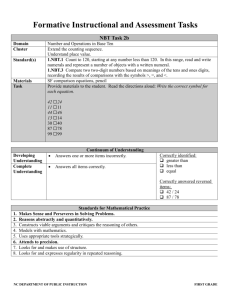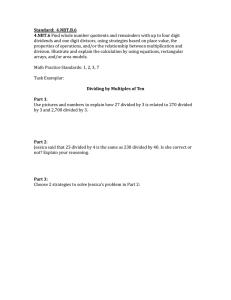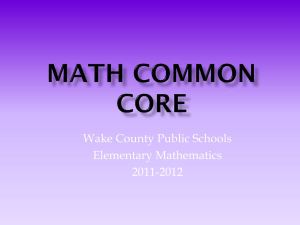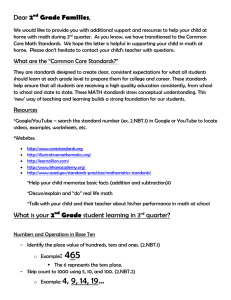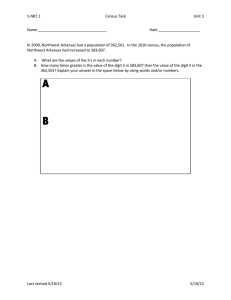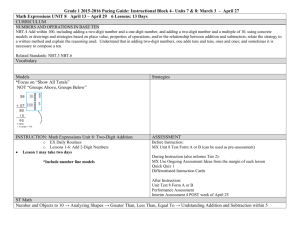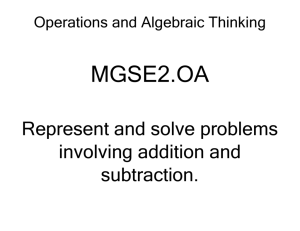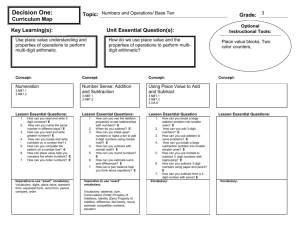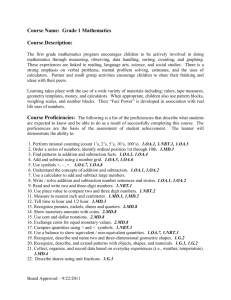Operations and Algebraic Thinking
advertisement
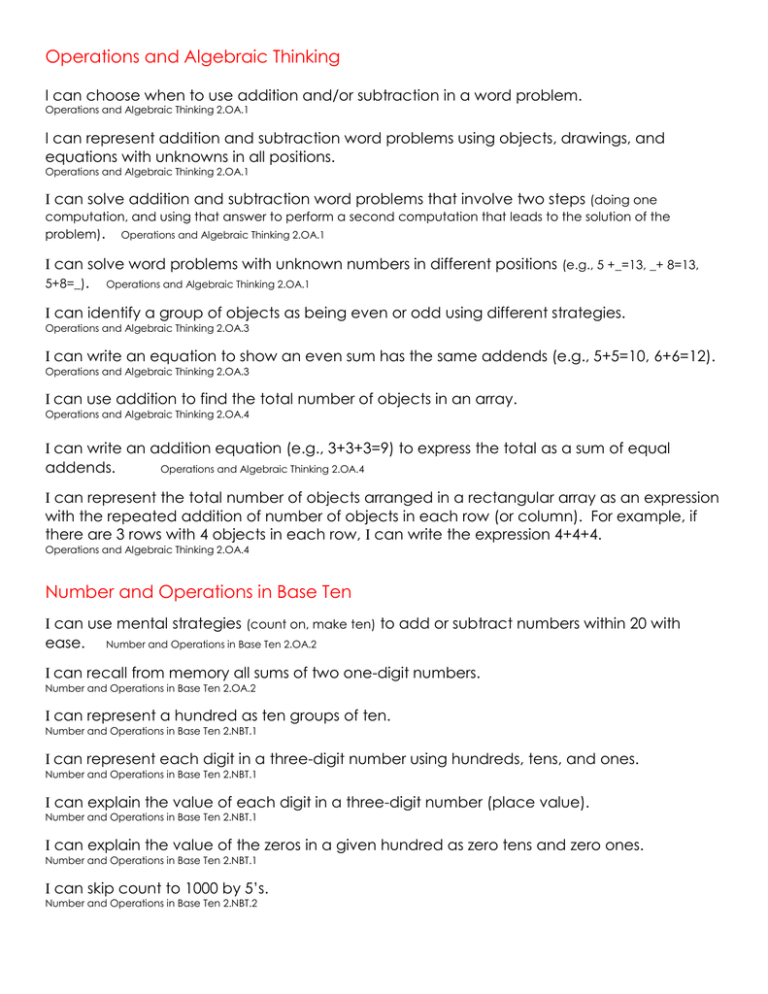
Operations and Algebraic Thinking I can choose when to use addition and/or subtraction in a word problem. Operations and Algebraic Thinking 2.OA.1 I can represent addition and subtraction word problems using objects, drawings, and equations with unknowns in all positions. Operations and Algebraic Thinking 2.OA.1 I can solve addition and subtraction word problems that involve two steps (doing one computation, and using that answer to perform a second computation that leads to the solution of the problem). Operations and Algebraic Thinking 2.OA.1 I can solve word problems with unknown numbers in different positions (e.g., 5 +_=13, _+ 8=13, 5+8=_). Operations and Algebraic Thinking 2.OA.1 I can identify a group of objects as being even or odd using different strategies. Operations and Algebraic Thinking 2.OA.3 I can write an equation to show an even sum has the same addends (e.g., 5+5=10, 6+6=12). Operations and Algebraic Thinking 2.OA.3 I can use addition to find the total number of objects in an array. Operations and Algebraic Thinking 2.OA.4 I can write an addition equation (e.g., 3+3+3=9) to express the total as a sum of equal addends. Operations and Algebraic Thinking 2.OA.4 I can represent the total number of objects arranged in a rectangular array as an expression with the repeated addition of number of objects in each row (or column). For example, if there are 3 rows with 4 objects in each row, I can write the expression 4+4+4. Operations and Algebraic Thinking 2.OA.4 Number and Operations in Base Ten I can use mental strategies (count on, make ten) to add or subtract numbers within 20 with ease. Number and Operations in Base Ten 2.OA.2 I can recall from memory all sums of two one-digit numbers. Number and Operations in Base Ten 2.OA.2 I can represent a hundred as ten groups of ten. Number and Operations in Base Ten 2.NBT.1 I can represent each digit in a three-digit number using hundreds, tens, and ones. Number and Operations in Base Ten 2.NBT.1 I can explain the value of each digit in a three-digit number (place value). Number and Operations in Base Ten 2.NBT.1 I can explain the value of the zeros in a given hundred as zero tens and zero ones. Number and Operations in Base Ten 2.NBT.1 I can skip count to 1000 by 5’s. Number and Operations in Base Ten 2.NBT.2 I can skip count to 1000 by10’s. Number and Operations in Base Ten 2.NBT.2 I can skip count to 1000 by100’s. Number and Operations in Base Ten 2.NBT.2 I can read and write numbers up to 1000 using base-ten numerals (e.g., 234) Number and Operations in Base Ten 2.NBT.3 I can read and write numbers using expanded form (e.g., 200+30+4). Number and Operations in Base Ten 2.NBT.3 I can read and write numbers up to 1000 using number names (e.g., two hundred thirty-four). Number and Operations in Base Ten 2.NBT.3 I can explain the process for determining whether a three-digit number is greater than, less than, or equal to another three-digit number. Number and Operations in Base Ten 2.NBT.4 I can determine when a three-digit number is greater than, less than, or equal to another three-digit number, and use the symbols <, >, = to compare them. Number and Operations in Base Ten 2.NBT.4 I can add and subtract numbers within 100 with ease by applying strategies (e.g., decomposing numbers into tens and ones, using communitive and associative properties, using mental strategies) based on the numbers being added or subtracted. Number and Operations in Base Ten 2.NBT.5 I can add up to four two-digit numbers by applying strategies (e.g., decomposing numbers, rearranging the order of the numbers, making tens or multiples of tens) based on the numbers being added. Number and Operations in Base Ten 2.NBT.6 I can use manipulatives or drawings to show how to add within 1000 using strategies based on place value regrouping). Number and Operations in Base Ten 2.NBT.7 I can use manipulatives or drawings to show how to subtract within 1000 using strategies based on place value (regrouping). Number and Operations in Base Ten 2.NBT.7 I can use manipulatives or drawings to show other strategies for adding and subtracting within 1000(communitive/associative prop. adding on). Number and Operations in Base Ten 2.NBT.7 I can explain, in writing, the steps that I followed as I used manipulatives or drawings to show how I added or subtracted. Number and Operations in Base Ten 2.NBT.7 I can mentally add 10 to a given number from 100-900. Number and Operations in Base Ten 2.NBT.8 I can mentally subtract 10 from a given number from 100-900. Number and Operations in Base Ten 2.NBT.8 I can mentally add 100 to a given number from 100-900. Number and Operations in Base Ten 2.NBT.8 I can mentally subtract 100 from a given number from 100-900. Number and Operations in Base Ten 2.NBT.8 I can explain addition and subtraction using place value. Number and Operations in Base Ten 2.NBT.9 I can explain addition and subtraction using the properties of operation. (order of addends, 0+#=#; associative, communative, identity). Number and Operations in Base Ten 2.NBT.9 Measurement and Data I can select an appropriate tool (e.g., ruler, yardstick, meter stick, measuring tape) to measure an object. Measurement and Data 2.MD.1 I can measure the length of an object using a tool. (e.g., ruler, yardstick, meter stick, measuring tape) Measurement and Data 2.MD.1 I can select appropriate units of length(e.g., inches, feet, centimeters, meter) to measure an object. Measurement and Data 2.MD.2 I can accurately measure an object with two different unit lengths. Measurement and Data 2.MD.2 I can compare the measurement of two different units (in./cm. or ft./m, etc.), and explain how the size of the unit length affects the measurement. Measurement and Data 2.MD.2 I can estimate the length of a given object in inches and feet. Measurement and Data 2.MD.3 I can estimate the length of a given object in centimeters and meters. Measurement and Data 2.MD.3 I can measure the length of any object in a given unit. Measurement and Data 2.MD.4 I can find the difference in length between two objects using standard units. Measurement and Data 2.MD.4 I can add and subtract lengths of the same unit within100. Measurement and Data 2.MD.5 I can represent addition and subtraction word problems involving lengths of the same unit by using drawings and equations with a symbol (e.g., blank or empty box) for the unknown length. Measurement and Data 2.MD.5 I can solve for the unknown number in an equation from a word problem involving lengths. Measurement and Data 2.MD.5 I can create a number line with whole number intervals (equal spacing). Measurement and Data 2.MD.6 I can represent whole numbers on a number line. Measurement and Data 2.MD.6 I can represent sums and differences within 100 using a number line. Measurement and Data 2.MD.6 I can explain the difference between a.m. (midnight to 11:59 a.m.) and p.m. (noon to 11:59 p.m.). Measurement and Data 2.MD.7 I can look at the time on an analog clock(uses hands), say what time it is, and write the time as it would be on a digital clock. Measurement and Data 2.MD.7 I can look at the time on a digital clock (to 5 min.), say what time it is and draw in the hands on an analog clock. Measurement and Data 2.MD.7 I can write the time and draw in the hands on an analog clock when someone tells me a time tothe nearest 5 minutes. Measurement and Data 2.MD.7 I can understand and use terms: half-past_____quarter after/past____ quarter to ____ ___minutes to____ ___minutes after/past ____ Measurement and Data 2.MD.7 I can identify and give the value of dollar bills, quarters, dimes, nickels, and pennies. Measurement and Data 2.MD.8 I can use $ (dollar) and ¢ (cent) symbols appropriately. Measurement and Data 2.MD.8 I can solve a word problem with dollar bills, quarters, dimes, nickels, and pennies. Measurement and Data 2.MD.8 I can measure and record the lengths of several objects to the nearest whole number. Measurement and Data 2.MD.9 I can create a line plot with a horizontal scale marked off in whole number units. Measurement and Data 2.MD.9 I can record length measurements on a line plot. Measurement and Data 2.MD.9 I can make a picture or bar graph with up to four categories to represent data. Measurement and Data 2.MD.10 I can compare data on a bar graph. Measurement and Data 2.MD.10 I can solve addition and subtraction problems using data from a picture or bar graph. Measurement and Data 2.MD.10 Geometry Shapes I can identify the defining attributes of a shape. Geometry 2.G.1 I can use defining attributes(e.g., number of sides, faces, angles) to name shapes(triangles, quadrilaterals, pentagons, hexagons, and cubes). Geometry 2.G.1 I can draw a shape when given defining attributes. Geometry 2.G.1 I can draw rows and columns of equal size in a rectangle. I can count the equal size squares in a rectangle. Geometry 2.G.2 Geometry 2.G.2 Fractions I can divide a circle and rectangle into two, three, or four equal parts. Geometry 2.G.3 I can describe the equal shares with words (e.g., halves, thirds, fourths). Geometry 2.G.3 I can describe a whole by the number of equal parts (e.g., two halves make one whole). Geometry 2.G.3 I can explain and give examples to show that halves, thirds, and fourths of an identical whole need not be the same shape (half of a rectangle can be shown horizontally or vertically). Geometry 2.G.3
